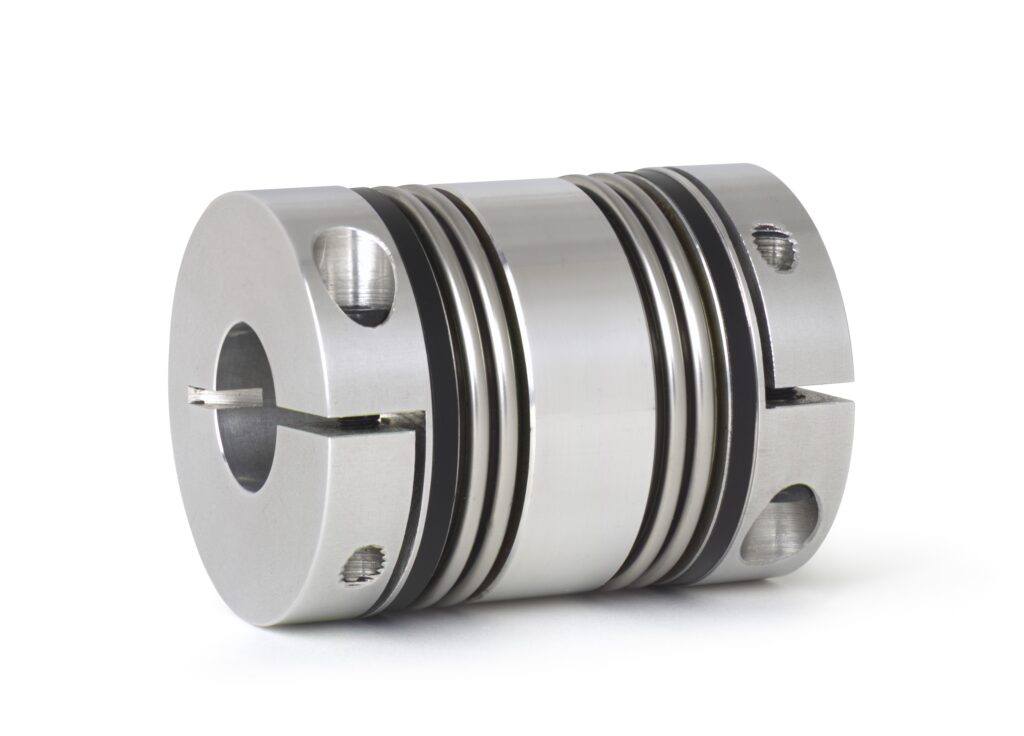Updated May 2019 || Physical values such as torque, torsional rigidity, spring stiffness, moment of inertia, imbalance, and zero-backlash play a major role in coupling design. Here are a few facts to keep in mind when you design your motion system.
1. Torque (Nm) is the product of an acting force and the effective length of the acting force’s lever arm:
T = F × r
Where T = Torque (Nm) … F = Force (N) … and r = Lever arm (m)
With a force of 100 N and a 1 m long lever arm, you can generate a torque of 100 Nm. Or you can generate a torque of 100 Nm with a force of 1,000 N and a 0.1 m long lever arm. For couplings, a specific amount of torque can be achieved with a large outer diameter of the coupling and a correspondingly low acting force or with a small outer diameter and a correspondingly high acting force.
2. Torsional rigidity (Nm/rad) refers to the rigidity of a coupling when it is subjected to a torsional load. If the torque exceeds the maximum torsional value of the coupling, the coupling will no longer be strong enough to transmit the acting rotational force. Ex: If a coupling with a torsional rigidity of 10 000 Nm/rad is subjected to 10 Nm, the connection element will twist by 1/1000 rad. That is equal to an angle of twist of about 0.057° — where 1 rad = 57°17’44.8”. For a torsionally rigid or vibration damping coupling, this angle of twist may still be within the admissible range. In practice, torsionally rigid couplings normally have a maximum angle of twist of less than 0.05° and vibration damping couplings have a maximum angle of twist of less than 5°.
3. Spring stiffness (N/mm) is the counterforce exerted by the coupling in case of differentiated position of the axes in an axial, radial, and lateral direction. Ex: If the axial spring stiffness of a coupling is 30 N/mm, the coupling will exert a force of 30 N in the case of an axial displacement of 1 mm. These forces are important in a design with couplings, particularly when selecting bearings or other drive system components.
4. Moment of inertia is the moment resistance when the rotational speed is changed. Normally, the lower the total weight and the smaller the outer diameter of the coupling body, the lower the moment of inertia. The reverse is also true, the higher the weight and larger the outer diameter, the higher the moment of inertia. This feature is important in highly dynamic applications because the drive has to generate sufficient torque to overcome a body’s moment of inertia to accelerate and decelerate.
5. Imbalance in a drive system should be as low as possible for smooth operation. Caused by asymmetries in the drive system where mass is distributed unevenly, it affects centrifugal forces on the entire drive system. It can be rectified by “balancing bores,” which are normally drilled directly into the location of the disproportionally high concentration of mass.
6. Zero backlash is a lack of looseness or “play” when the rotational speed, direction of rotation, or torque changes. It does not mean that there is no angle of twist. Backlash is an important factor in predicting bearing life.
Information courtesy of R+W America | rw-america.com
